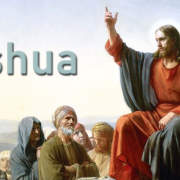Was Jesus Jewish?
In 1938, French-Jewish artist Marc Chagall painted “White Crucifixion,” which depicts Yeshua as a Jewish man hanging on a tree.1 He is wearing a prayer shawl and is surrounded by images of contemporary persecution: a synagogue is burned, a man tries to save a Torah scroll, and a group of refugees flee by boat. There are, of course, many pieces of art that portray Yeshua’s death, but Chagall’s rendering uniquely emphasizes his Jewishness and connects his suffering with that of Jewish people in twentieth-century Europe.
Unfortunately, the fact that Jesus was Jewish has been largely overlooked for centuries. The New Testament accounts of Jesus’ life demonstrate that he had both a Jewish background and lifestyle. He came from a Jewish family; in fact, Jewish feminist theologian Melissa Raphael draws meaning from Michelangelo’s Pietà (a statue depicting Yeshua’s mother Mary holding his body after his death) as an “image of a Jewish mother cradling her murdered son.”2
Scripture also describes Jesus as the son (descendant) of David, Israel’s greatest king and the one from whose lineage the Messiah would come (Romans 1:1–3). He was born in Judea and spent most of his life in the land of Israel. Growing up, Jesus’ parents took the family to Jerusalem every year to celebrate Passover (Luke 2:41). As an adult, he continued to observe the holidays, including Hanukkah, which the Bible calls “the Feast of Dedication” (John 10:22–23).
Yeshua attended synagogue regularly (Luke 4:16), and it was there that he did much of his teaching and miracles. For example, he once healed a man with an injured hand at a synagogue. When this healing caused some to accuse him of working on the Sabbath, he defended his action by saying that saving a life is more crucial than ritual obedience, a statement that is itself an illustration of the value placed on human life in Jewish culture (Mark 3:1–5). On many other occasions, he taught in synagogues, and people were astonished by his wisdom (Mark 6:2; Luke 4:44).
One of the clearest passages related to Yeshua’s Jewishness is his conversation with a Samaritan woman. The Samaritans were a group of people who claimed to be descendants of Israel, but disagreed with the Jewish people on significant matters, such as the proper place of worship. Despite the animosity between Jewish people and Samaritans in the first century, Yeshua willingly sparked a dialogue with this woman whom he encountered while travelling. She was surprised and asked how he, a Jewish man, could talk with her (John 4:9). In characteristic Jewish fashion, Yeshua responded to her question with a question (John 4:10) and employed the first-person “we” when referring to Jewish people (John 4:22).
Jesus’ teaching is firmly rooted in the Hebrew Scriptures. He considered what is known as the “Golden Rule” to be a summation of the Hebrew Bible’s moral precepts (Matthew 7:12). Another of his most famous sayings is a direct quote from two passages in the Torah. A man asked Jesus what the greatest commandment was, and he responded with the Shema: “Hear, O Israel: The Lord our God, the Lord is one. And you shall love the Lord your God with all your heart and with all your soul and with all your mind and with all your strength” (Mark 12:29–30; cf. Deuteronomy 6:4–5). The second greatest commandment, Jesus said, comes right from the Torah as well: “love your neighbor as yourself” (Mark 12:31; cf. Leviticus 19:18). Jesus never despised or sought to set aside the Hebrew Scriptures; rather, he embraced them and taught his listeners to do the same.
Yes, Jesus was Jewish, and in fact, he is the most influential Jewish person who ever lived. The bulk of his teaching and healing was directed to other Jewish people, and yet he was influential among Gentiles as well. More than 2.5 billion non-Jews follow him today, as well as a growing number of Messianic Jews. For centuries, both Jewish people and Gentiles have put their trust in him. Indeed, he is “a light for revelation to the Gentiles, and for glory to your people Israel” (Luke 2:32; cf. Isaiah 11:10; 42:6). The salvation he offers through his atoning death and resurrection is available to Jewish people and Gentiles—to all who believe in him.
Footnotes
- Marc Chagall, White Crucifixion, 1938, oil on canvas, The Art Institute of Chicago, Chicago, accessed June 15, 2020, https://www.artic.edu/artworks/59426/white-crucifixion.
- Melissa Raphael, “The Kiss of the Shekhinah: Narratives of Human and Divine Motherhood in the Holocaust,” Temenos Vol. 42 No. 1 (2006): 93-110.








